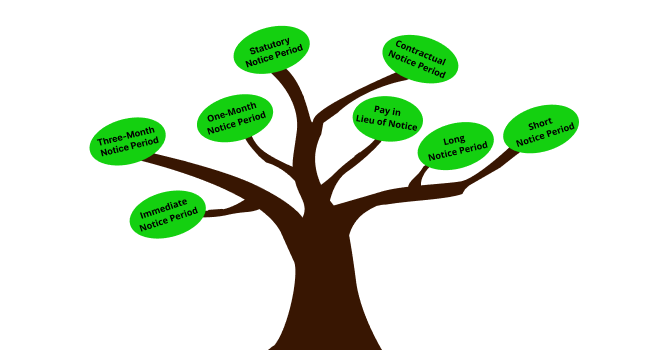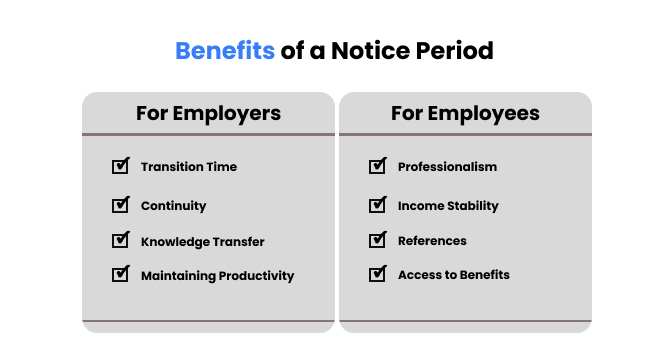The notice period – that sometimes awkward and often overlooked phase in a professional’s journey. Whether you’re leaving a job on your own terms or because circumstances have dictated it, the transition period is a crucial bridge between your current and future endeavors.
What is a Notice Period?
A notice period is the duration between the moment an employee formally submits their resignation and the date their employment officially terminates. This period allows both the employer and the employee to make necessary arrangements and adjustments for the impending departure, ensuring a smooth transition.

Types of Notice Period
Notice periods can vary in length, and there are eight main types
1. Statutory Notice Period:
This is the minimum transition period required by employment laws and regulations in a particular jurisdiction. It is usually a baseline period that employees must provide to their employers when resigning. The length of the statutory transition period can vary from country to country and is often based on the employee’s length of service.
2. Contractual Notice Period:
The contractual transition period is stipulated in the employment contract between the employer and the employee. It may be longer than the statutory transition period and can depend on various factors, including the nature of the job, seniority, or industry norms. Employees and employers are legally bound to adhere to the terms of the employment contract.
3. Short Notice Period:
In some situations, employees may be allowed to provide a shorter transition period than what is required by law or their contract. However, employers are not obligated to accept a shorter transition period, and they may negotiate with the employee to extend it or provide compensation for the reduced transition period.
4. Long Notice Period:
Certain roles or industries, such as highly specialized positions or those involving sensitive information, may require a longer transition period. Employers often require a longer notice period to ensure a smooth transition and adequate time to find a suitable replacement.
5. One-Month Notice Period:
A one-month transition period is relatively common and falls within the range of standard notice periods in many countries. It provides a reasonable amount of time for both the employer and employee to adjust to the impending departure.
6. Three-Month Notice Period:
A three-month transition period is considered a more extended duration. It is often required for senior management positions, highly specialized roles, or in industries where extended transitions are necessary due to the complexity of the work or the industry’s specific demands.
7. Immediate Notice Period:
In some cases, an employee may be asked to leave their job immediately upon submitting their resignation. This can occur if the employer believes the departing employee’s presence may be disruptive or pose a risk to the company’s operations or sensitive information.
8. Pay in Lieu of Notice:
When an employee wishes to leave their job without serving the transition period, some employers may offer “pay in lieu of notice.” In this scenario, the employer compensates the employee for the notice period they are not working. This allows the employee to leave immediately while still receiving payment.
Each type of transition period has its unique characteristics and implications for both employees and employers. It’s crucial for individuals to be aware of the specific transition period requirements in their employment contracts and under local labor laws. Understanding these variations can help ensure a smooth and professional departure from a job while adhering to legal and contractual obligations.
What is the Usual Notice Period in a Job?
The typical transition period varies from country to country and can also depend on the industry and the terms of the employment contract. It can range from 1 to 3 months in many cases, with certain positions requiring longer notice periods due to their complexity.
How Can Notice Period be Implemented?
Notice periods are typically initiated by the employee submitting a formal resignation letter to their employer. The employer, in turn, acknowledges the resignation and informs the employee of the length of the transition period. During this time, the employee is expected to continue performing their duties and responsibilities.
Why is the Notice Period Important?
Notice periods hold significant importance for both employees and employers for several reasons:
Smooth Transition: It provides time for the employer to find a suitable replacement and for the departing employee to wrap up their tasks.
Legal Compliance: Adhering to transition periods ensures compliance with labor laws and contractual obligations.
Professionalism: Respecting transition periods reflects professionalism and ethical conduct in the workplace.
Knowledge Transfer: Employees can use this time to pass on their knowledge and responsibilities to colleagues, facilitating a seamless transition.
Tasks an Employee Works on During the Transition Period
During the transition period, employees are expected to continue their regular job responsibilities. In addition, they may need to document their work processes, train their colleagues, and assist in the hiring or training of their replacements.
Benefits of a Notice Period for Employers and Employees
For Employers:
Transition Time: Employers can find a suitable replacement without rushing the hiring process.
Continuity: It allows for a seamless transition, reducing disruptions in workflow.
Knowledge Transfer: Existing employees can train their successors and ensure a smooth handover of responsibilities.
For Employees:
Professionalism: Respecting the NP demonstrates professionalism and a commitment to ethical work practices.
Income Stability: Employees continue to receive their salary during the transition period, providing financial stability.
References: A positive departure experience can lead to better references and networking opportunities.
Conclusion
The notice period is a vital component of the employment journey, serving to ensure a smooth transition when an employee decides to move on. Understanding its types, significance, and benefits can help both employers and employees navigate this phase effectively, maintaining a professional and ethical workplace environment.



